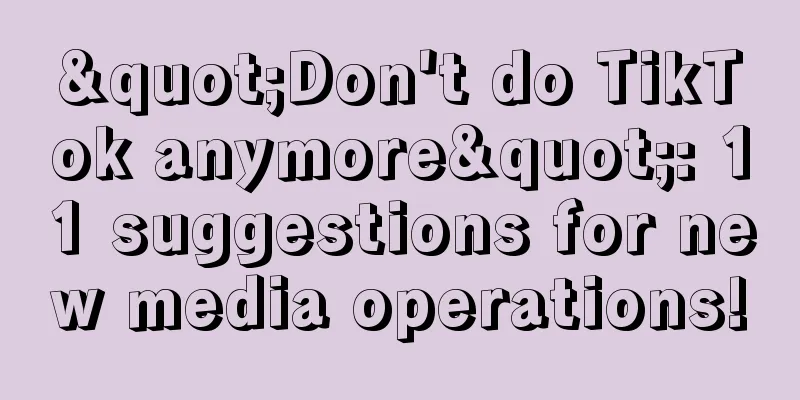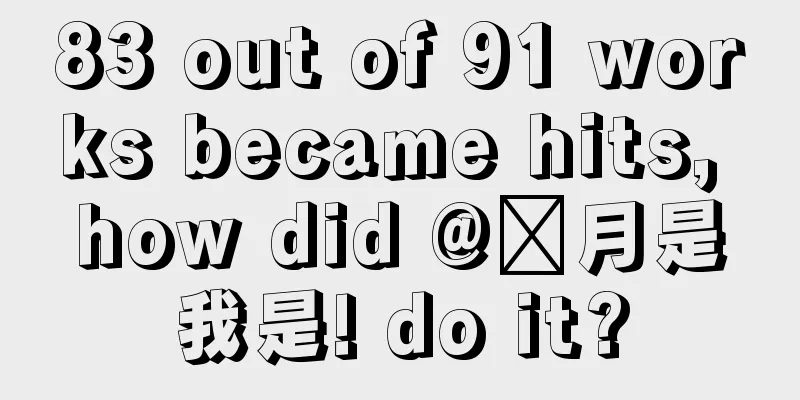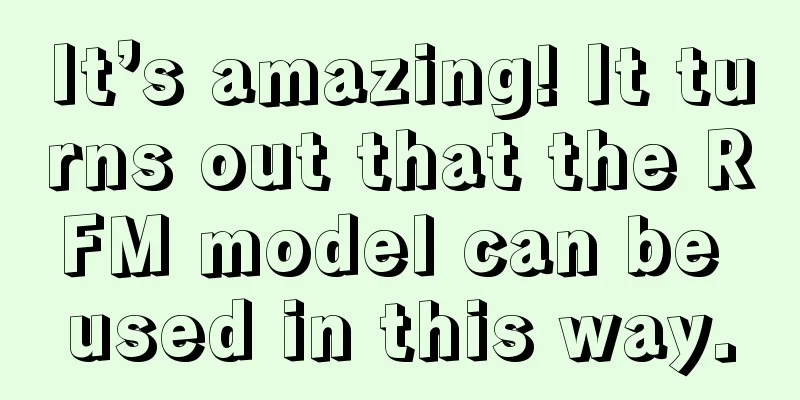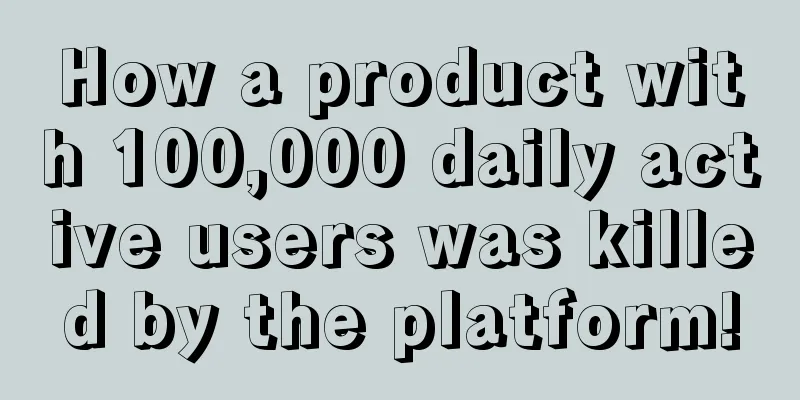"Don't do TikTok anymore": 11 suggestions for new media operations!

As you can see, it is getting harder and harder to do it, whether it is Douyin or WeChat official accounts. The opening rate, sharing rate, like rate and completion rate are all declining. In fact, you don’t even need to look at the big data. Just look at the people around you, including the top, middle and bottom accounts, and they all reflect that the data is declining. So, some people say don’t create public accounts anymore, they are a thing of the past and will soon die. Don’t create TikTok either, the traffic dividend is over. This sounds familiar. Some people say this on Weibo, some people say this on Xiaohongshu, and now some people say this on Douyin. Some people even say that companies should stop updating their Weibo and Douyin accounts. Well, since the birth of new media, these people have been saying this almost every year. I see that many people have also started to criticize TikTok, which is quite boring. Everyone has their own opinion. This topic is boring and meaningless to discuss. If you are still doing self-media or new media in the enterprise, then I would rather give you 11 suggestions for new media operations, which is more practical. 01Familiar things and familiar scenes are not attractive; breaking cognition is what attracts people. Generally speaking, there are four types of new media content:
Obviously, the first type, "talking about familiar things with familiar things", is too poor to arouse any interest; the fourth type, "talking about unfamiliar things with unfamiliar things", will only bring a sense of strangeness and make people stay away. The third and second types are more popular. They both break people’s inherent cognition, bring some new cognition and surprises, and arouse users’ curiosity and desire to explore. Of course, I personally prefer the second one, which starts from familiar things and brings fuller and more novel content. Because like = familiarity + surprise. To operate new media, you must cultivate "reverse thinking", that is, to break some norms, put forward opposite views, and create conflicts. For example, "How to manage your boss?", "A good figure is mostly achieved by eating", "How I went from CEO to ordinary employee step by step", etc. An unexpected topic angle with reasonable content will subvert everyone's conventional cognition, thereby arousing interest and effectively attracting users. Moreover, if you don’t click on this kind of content that breaks your cognition, you will feel uncomfortable! 02Curiosity and relevance to "me" are strong guarantees for attractive content. Every day, countless pieces of content are flying around. It takes less than a second to scan the title or cover and read them as quickly as possible. If you like it, read it. If you don’t like it, close it. If you love it, follow and like it. If you hate it, unfollow or even report it. This is the current status of new media content. So what kind of content are people generally interested in? There are two directions that I think are certain: 1. To satisfy curiosityCuriosity is one of the core motivations of human behavior and the most reliable topic selection direction for content creation. Human curiosity is endless. Everything that is unknown, new, subversive, innovative, improves skills, increases knowledge, leaves suspense, etc., can easily arouse people's interest. 2. Related to mePeople will always care about the content related to themselves, but not necessarily the other content you talk about. It is just like people will always care about what benefits a product brings to "me". Especially in an era where attention is extremely scarce, content is strongly associated with users and highly relevant to "me", which gives us more opportunities! Whether it is video, audio, graphics, or comic strips, when creating content, you can first highlight the relevance to "me" and use more information within the user's circle of concern. For example, many accounts will deliberately create a character and tell stories with similar experiences to the target group, so that users will think, "Isn't this talking about me?" The result is a high degree of involvement. Some people will clearly describe the region, age, dialect, gender, occupation, social identity and other labels of the corresponding group of people, so that users can know at a glance that this information is related to "me". For example, "Social Guide for Post-80s and Post-90s". 03Having flaws makes a person’s personality more complete. People born in the 1990s, 1995s and even 2000s are increasingly becoming the main consumer force on major platforms, and more and more brands want to win the favor of this group by targeting younger people. What do young people like? It doesn’t have to be a big brand. What’s more important is a brand that they recognize and feel has personality. Such brands are like friends, with whom you can share your heart, play together, cry together, and complain together. They don’t have to be perfect, but like a real person, with both strengths and weaknesses, and are no longer like the brands of the past that build up a high-end image every day. The same is true for new media operations. One of the biggest changes in the new media era is the personalization of the platform, which means that it has flesh and blood, advantages and disadvantages. When you have complaints, it is easier to narrow the distance with users and your personality is more complete. Don't create a perfect persona, it's tiring and annoying. Make fun of yourself and entertain others. 04If you want more shares and reposts, you have to create more stimulation. Everyone in this industry wants to get more shares, so first of all, the content itself must be solid. This is the foundation of everything and the strongest stimulation point. The content has no value and is illogical. People will close it immediately. How can it be shared? Then, your content needs to have more points that stimulate sharing. Just like selling a product, we need to have clear selling points. If you want to spread an article or a short video, what is the "selling point" of this content that makes people share it? You can think carefully:
These are all effective means to induce social sharing and help users better establish their ideal image in social relationships. Of course, if you manage your relationship with users well and interact with them frequently, if you have copywriting that guides sharing, and if you initiate activities to promote sharing in the content, such as sharing to get red envelopes, sharing to get information, joining groups, discussing topics, etc., these are also points to stimulate sharing. One point to emphasize is that the effect of forced sharing is definitely not as good as active induction, and sharing cannot harm the interests of users. For example, if your content is called "People in my friend circle are all pigs", it may be well shared on weak social platforms, but how about on a strong social platform like WeChat? Do you think readers will share it on their friends circle? Obviously, we also need to consider the positivity of the content, the content itself can't be too negative. Especially the title, you need to manage the user's expected experience. Because he doesn't want to be a disseminator of "clickbait", and he doesn't want to give his friends the same expected experience. 05Sharp opinions are the triggering points. Sharp viewpoints and unique insights have always been the darlings of new media content dissemination. For many popular topics, the angles may be the same, the hot topics may be the same, and the stories may be the same, but the novel perspectives are unique. Whether you are doing Douyin or WeChat public account, your content must have its own stance and opinions. If the content is good, it is only of high quality and everyone will like it. But opinions with personal will are the weapon to encourage users to resonate and share, and opinions are often the trigger point. I know many people who like to read the comments one by one on Weibo, and they are much more serious than reading the text. Some people even say: I only read the comments on Weibo! Why? It turns out that there are many experts among the people, and many of the opinions in the comment section are so sharp that they are simply fascinating. A lot of popular content is not because of their good writing skills or strong technical skills, but because they have new perspectives and work hard to dig out new insights into life. Although there is nothing new under the sun, people's favorite topics have not changed, such as straight male cancer, struggle and counterattack, hatred of the rich, and extraordinary love, etc. But for the same topic, you need to have a clear point of view and attitude. The point of view is the hot spot, and the attitude is the temperature. Otherwise, if there is no novelty, everyone will get bored. Where do the opinions come from? If you can't come up with them, read more about the experts in the comment section. Without opinions, moderation equals mediocrity. 06Pay attention to self-expression, but also consider user needs. When working in new media, you must have your own attitude and express your own opinions, that’s for sure. Everyone is emphasizing the need to have individuality and form one's own unique style, which is self-expression. However, self-expression is not self-satisfaction, nor is it a one-man show. It is the middle area between user needs and oneself. You see, there are many big Vs who seem to do their own thing all day long and have very strong personalities. That’s because they have clearly thought about their positioning and have considered what kind of users they want and the corresponding user needs. We don’t do whatever users like, as that would mean we lose the ability to express ourselves; nor do we say whatever we think, or do whatever users dislike. An account that is fun, easy, and sticky should be one that constantly explores the intersection between self-expression and user needs. 07Learn to show off reasonably, not too low nor too high. People don’t like to read highbrow stuff, and they can’t stand particularly profound arguments. If we look at it from a longer time span, people often like content that doesn’t go too far beyond their cognition and is just within their reach if they stand on tiptoe. This requires operators to learn how to "pretend reasonably". This means that the opinions you express and the content you output can be of a certain level. However, this level should not be too high, and should be slightly higher than the target user's cognition and knowledge. In this way, users can gain continuous satisfaction, surprise and identity recognition. The quality is too low, there is nothing new, people are not interested and don’t watch it. It's too high-brow, I can't get it, I can't understand it, and I won't watch it. This is why it is always said that creating content is not just about creation, but also about learning to understand users and even letting users participate in the creation. Even if you know a lot, don't show off too much in front of users. Because you have your positioning, and finding the intersection between self-expression and target groups is what an operator should do, rather than falling into the "curse of knowledge." Users are constantly growing, and when your content is a little bit better than theirs, they will stay. But when they grow to the point where you can no longer "show off" in front of them, they will of course leave. If you want to stay ahead, you need to provide content that is a little higher than theirs. Only by being a little higher than theirs can you succeed in showing off and gain recognition. 08There must be enough reasons for people to pay attention, and the threshold must be very low. No matter what kind of content you create or what efforts you make, in the end more people will pay attention to you. But the question is: Why should others pay attention to you? In a word, you have to provide new people with enough reasons to pay attention. There is no need to talk about the content itself. As I said before, it must be solid. Next is the verticality and continuity of your content. Generally, when a new user sees your content and thinks it’s good, he will look at your previous content. If he finds that your past content is messy and you only post once every few months, he will probably not pay attention. You can also prepare some activities that reward followers with gifts, such as getting an information package/tool kit/discount package/course package after following someone/joining a fan exchange group after following someone, etc. Some accounts like to do serialization, so that new users will be satisfied with the content and will naturally pay attention to it and want to continue to watch the next series of content. Some accounts will make a preview of the next issue, the same principle applies. Of course, you also need to guide attention in the content. You know, a few new users will want to follow you, but most people are in a state where they can follow you or not. At this time, an obvious reminder to follow will play a role of "psychological suggestion". The difference between paying attention and not paying attention may be just "guidance". In general, the more sufficient and tempting the reasons for attention you provide, the lower the threshold, and the greater the volume. And any extra step you take to attract attention is better than doing nothing. 09Good titles are selected through screening. There is no need to explain the importance of titles. It is estimated that all the top new media teams in the country are studying how to write better titles. In other words, it’s not about “writing” better ones, but about “screening out” better titles. If you want your headline to be more effective, don’t rely on one person’s judgment to write it. Let’s try to rely on science:
For example, the Mi Meng team was said to have selected 100 titles and 5,000 people voted. They would send the selected 100 titles to the 5,000 core fans for voting, not relying on their own guesses, and always leaving the "insight" to the users themselves. You should often hear that a good title should be chosen 100 times. If you can do it, it is a great asset in itself. Of course, teams with the conditions will also have small accounts with similar fan attributes. The final title will be tested on the small account in advance and then used on the main account to maximize the opening rate of each content. 10Don’t be too rigid, you need to find a benchmark to “copy” the best-selling products and summarize the routines. There are many people doing Douyin now, and it is getting harder and harder to make an account. It is very tiring to just work hard, and there is no improvement at all. In fact, there are still some tricks. When we create TikTok, the core is two things: content and operation. To create good content, the first thing to do is to determine the direction, IP, user group, and track. Then, look for popular videos, popular topics, popular titles, and benchmark accounts that can be imitated. You can use Douyin's official data platform, Juliang Backstage, Douyin Hotspot, Xindou, Chanmama, etc. to pull out accounts with popular content in the same track. Next, disassemble it, disassemble it ruthlessly, the finer the granularity the better, and sort out all the good things to form a material library. Next, you need to imitate and copy one by one, or you can combine several popular gameplays to copy. Of course, you don’t have to work hard. You need to test and summarize, that is, to verify the feasibility and find a way. Finally, round after round, delete the videos with poor data, appropriately promote the videos with good data, and continuously optimize the structure of hot products. That's about it. There must be a process and method, instead of just doing it haphazardly, or being very rigid and figuring it out by yourself, which will stall after a few days. What is the most important thing about operation? I think there are several key points: The first is to streamline the operation execution and detailed SOP; the second is to fix 90% of your work and repeat it efficiently every day; the third is to continuously innovate and optimize the 10% of your work. This ratio does not need to be too high. It is already quite impressive to be able to thoroughly perform fixed work; the fourth is to understand your peers, benchmark your peers, and find hot cases to "copy"; the fifth is to review frequently, summarize the good parts, keep them, optimize the deficient parts, eliminate the poor parts, and continue to iterate. Don't stand still. If you do these 5 things well, you won’t do too badly. 11New media positions have never been just purely creative positions. When you first start operating new media, you don’t need to have a deep understanding of the product, sales logic, and brand. It is enough to build up fans, find good topics, output good content, and preferably make some hits. It is basically a situation of wild growth and expansion. But this would have been fine in the past. Now more and more companies are result-oriented and performance-oriented, requiring refined operations and marketing. You need to have a deeper understanding of the product and business logic, pay attention to conversion rate and strategy effect, and attach importance to product thinking and marketing thinking. I have always felt that these are the hard skills that new media operations should have, but now these capabilities are more needed. Especially in the past few years, we have seen countless new media operators start to work harder on conversions, or slowly transform, and some have even been directly eliminated. There is no other way. At least, you have to operate new media from the perspective of products or brands. Pure creation is not enough. |
<<: 8 tips for making money with gadgets
>>: Brands are adjusting their communication context
Recommend
Is Shopee a scam? Is it a pyramid scheme?
Currently, you do not need to pay platform usage f...
Is it easy to be a domestic seller on Lazada? Why?
Lazada is also one of the cross-border e-commerce ...
When a “boss” becomes an “Internet celebrity”, how should he build his personal IP?
Recently, Baidu Vice President Qu Jing posted seve...
How can brands create explosive social currency?
The author of this article introduces in detail th...
Where is the entrance to Amazon North America? How to operate after opening?
As one of the world's largest e-commerce compa...
What is the ranking of cross-border payment platforms? Which one is better?
Now everyone will use some cross-border e-commerce...
What does it mean to do reviews on Amazon? What are their uses?
As the Amazon platform continues to grow, more and...
What bank cards does eBay support? Can eBay use UnionPay cards?
The products on the eBay cross-border e-commerce p...
The key to brand marketing——fast thinking
This article introduces what fast thinking is, sev...
How to add a carousel to an independent website? Is it easy to build an independent website?
In today's Internet age, an excellent website ...
From the sudden popularity of Zibo barbecue to the branding of internet celebrity cities by short video/live streaming experts!
Zibo barbecue has become popular on social media. ...
12,000 words to interpret Luckin Coffee's joint marketing strategy: Special Forces in the Traffic Pool
As the traffic king this year, do you understand t...
What are the top 10 best-selling products on Amazon? What are the unpopular but highly profitable products?
There are many types of products on the Amazon pla...
Will Shopee's cross-border business account be blocked? What should I do if Shopee stops accepting orders after placing a few orders?
With the continuous improvement of platform rules ...
Thinking about making the brand bigger
This article mainly analyzes the eight elements of...









